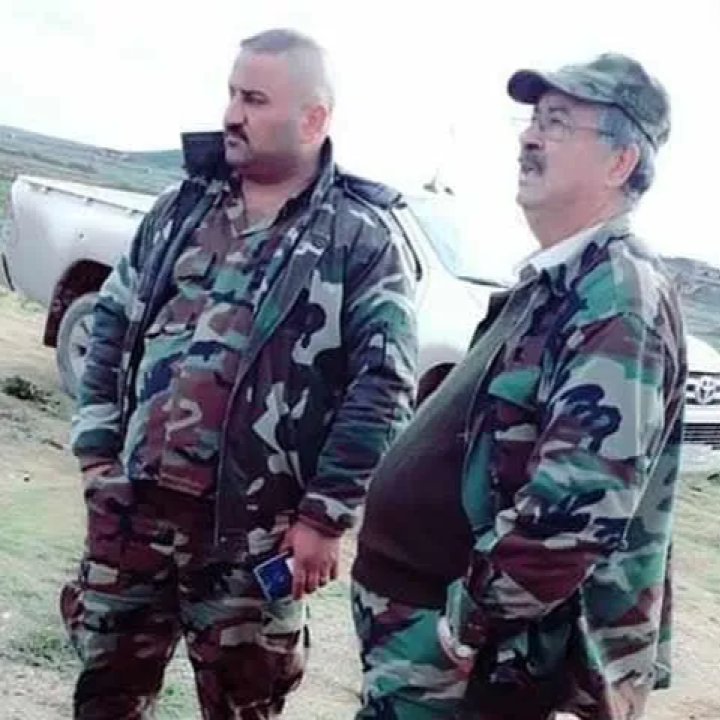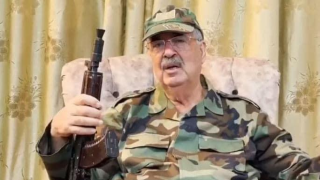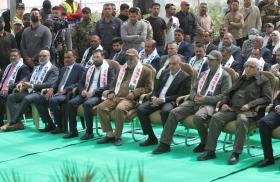
Profile: Hashemite Tribes Regiment

Part of a series: Militia Spotlight: Profiles
or see Part 1: How to Use Militia Spotlight: Profiles
With support from Iran's Islamic Revolutionary Guard Corps, this regiment aims to create a more cohesive force capable of opposing the U.S.-backed SDF on the eastern banks of Syria's Euphrates River.
Name: Fawj al-Ashair al-Hashimiya (Hashemite Tribes Regiment, or HTR)
Type of movement: Tier 3 fasail (armed group) engaged in kinetic military and paramilitary actions in Syria, particularly in the eastern region that includes Deir al-Zour. Primarily focused on combating the U.S.-allied Syrian Democratic Forces (SDF), reinforcing Arab tribal power, and opposing Kurdish influence.
History:
- On August 30, 2023, the SDF announced the dismissal of Ahmad al-Khabil (aka Abu Khawla), commander of the Deir al-Zour Military Council. This led to clashes between SDF personnel and gunmen affiliated with both Khabil and Nawaf Ragheb al-Bashir, a top Baggara tribal federation leader and pro-Iranian figure whose groups are active in areas west of the Euphrates River controlled by the Assad regime or Iran.
- On September 11, 2023, officers from Iran's Islamic Revolutionary Guard Corps (IRGC) held a meeting with Bashir and various local militia commanders in Deir al-Zour province (either the town of al-Hatla or Mayadin). The meeting resulted in an agreement to form a new militia with an Arab tribal character in areas controlled by the Assad regime east of the Euphrates. Other attendees included the regional commander of the regime's irregular National Defense Forces (NDF)—Mohammed al-Raja, a Syrian national—as well as Abdul-Sahib al-Moussawi from Iraq and Hajj Abbas from Iran.
- Iranian officials selected several figures to work with HTR, including Abdullah al-Shlash, Ghanim al-Suleiman, Ahmad Salama, and Fares al-Khedr. Shlash leads local reconciliation process between opposition elements and the Assad regime. Suleiman is a former official in the Islamic State's Tribes Office but now works on the Reconciliation Committee. Salama is former mayor of Shumaytiyah and is known locally as a mediator who facilitates cooperation with Iran-backed militias. Khedr recruits Deir al-Zour youths and intellectuals to work for Iran. Ultimately, Bashir formed the regiment and now leads it, leveraging his position as the sheikh of Syria's largest tribe.
- HTR consists of around 1,000 militants. Most of them are affiliated with Bashir, while Shlash, Suleiman, and Khedr have recruited small companies of young men from Deir al-Zour (with 80, 50, and 150 fighters, respectively). New recruits are paid 500,000 SYP monthly (about $33); they also receive food rations and security cards that enable them to move freely in the area.
- HTR is based in seven villages controlled by regime forces and Iran-backed militias on the eastern bank of the Euphrates: Husseiniyah, Salihiyah, al-Hatla, Maarat, Mazloum, Khasham, and Tabiya. The Iranian presence in these villages facilitates Iranian attacks on U.S. bases within areas controlled by the Autonomous Administration of North and East Syria (AANES).
Objective: HTR's primary objective is to fight SDF units in order to strengthen Arab tribal control east of the Euphrates. A secondary objective is to strengthen Iran's grip in this area and push U.S. forces out of Syria. Areas under SDF control are generally inaccessible to Iranian proxies in the so-called "axis of resistance," so gaining a foothold in these zones would enable the IRGC to establish a northern land corridor leading to Aleppo.
Chain of command:
- Nawaf Ragheb al-Bashir: Associated with the Baggara tribal militia Liwa al-Baqir, Bashir also commands the IRGC-affiliated "Lions of the Tribes" militia, which runs local smuggling networks in coordination with the Syrian military's 4th Division. In late September 2023, Bashir stirred Arab tribes and clans against the Kurdish-led SDF in what observers identified as clear hate speech.
- Islamic Revolutionary Guard Corps: Iran has strengthened its influence in Deir al-Zour by effectively leveraging connections with Hashemite tribes linked to descendants of the Prophet Muhammad. This trend has been especially evident with tribes such as the Baggara, Mushadah, and Marasima, all of whom have supported Iran-backed militias. Preferring Iran over the Assad regime, many tribes helped form militias such as Liwa al-Baqir and the Lions of the Tribes, who are closely associated with the IRGC's Qods Force. Often led by either Iranian commanders or local figures who follow Iranian directives, these militias focus on activities such as smuggling and guarding military posts. With the majority of tribal leaders in Iranian-controlled areas aligning with Tehran, Bashir's recent unification of these militias under one banner indicates a significant consolidation of tribal and Iranian power in the region.
- Assad regime: The regime has equipped HTR with heavy weaponry and gear. It also facilitates the mobilization and transfer of HTR units and other tribal militias, enabling them to cross the Euphrates and engage the SDF. In addition, the regime is instrumental in transporting recruits to and from areas under tribal militia control, playing a crucial role in their operations. In September 2023, Foreign Minister Faisal Mekdad announced the regime's full support for Arab tribes fighting U.S.-aligned groups in east Syria, emphasizing their efforts against the SDF.
Affiliate relationships:
- National Defense Forces: HTR works alongside multiple smaller NDF factions in east Syria. Moreover, the regional NDF headquarters established in HTR's seven core villages now operates under the name “Popular Resistance."
- Russia:
- In 2022, Moscow played a pivotal role in supporting Iran's efforts to construct a floating bridge over the Euphrates. Connecting Deir al-Zour city with al-Hatla, the bridge greatly facilitated the movement of Iran-backed militias and NDF units toward territories held by the AANES.
- Around the same time, Russian military police deployed to the seven main villages in the area. Local activists interpreted this as an effort to safeguard the interests of both Iranian militias and Assad-aligned forces amid the presence of U.S.-led coalition forces in the area. This development underscores the depth of Russian involvement in shaping the dynamics of power and protection in Deir al-Zour.
- In September 2023, Bashir and other tribal leaders met with Gen. Igor Smoly, deputy commander-in-chief of Russia's forces in Syria, and "General Andrei," the head of the Reconciliation Center in Deir al-Zour. The meeting's purpose was to mobilize tribal forces against the SDF and the U.S.-ledcoalition.
- Baggara tribe/Liwa al-Baqir: In 2017, Liwa al-Baqir orchestrated the reconciliation of Bashir, who had previously supported the Syrian opposition but later aligned himself with the Assad regime. Afterward, Bashir moved to Damascus, where he verbally attacked the United States and SDF while discussing plans to raise an “army of tribes” to retake Deir al-Zour with Iran's help.
- Liwa Abu Fadl al-Abbas (LAFA): Muhammad al-Khalouf, a LAFA commander, was “appointed by the people of Mayadin” to supply Iran-backed tribes with food, supplies, and accommodation.
- Sons of Jazira and Euphrates Movement: On September 8, 2023, the movement's Facebook page released a video showing Bashir vowing to undertake aggressive actions against the SDF. The movement’s leader, Sheikh Ibrahim al-Hifl, is also a high-ranking figure in the Ougaidat tribal confederation, whose activities and statements significantly overlap with those of the Baggara.
- Other tribal militias: Bashir leads other Arab tribal militias in east Syria, particularly in Deir al-Zour (e.g., Lions of the Tribes). He also wields influence over additional tribal militias, including the Lions of the Ougaidat Brigade and the Arab Tribal and Clan Forces, with whom he collaborates closely.
Subordinate relationships:
- HTR appears to have around eight companies: five affiliated with Bashir and one each with Shlash, Suleiman, and Khedr.
- The regiment does not have any known media organs, not even social media pages.







